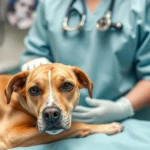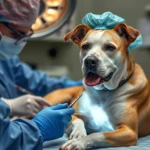
Introduction
Understanding dog health care is crucial for every pet owner. Just like humans, dogs have unique anatomical features that can raise questions, particularly when it comes to their reproductive systems. One common question that arises is, why do male dogs have nipples? It’s an intriguing topic that many pet owners might overlook, but it holds significance in understanding canine anatomy and health.
In this article, we will delve into the anatomy of male dogs, explore the evolutionary and biological reasons behind the presence of nipples, and discuss the health implications related to this feature. By the end, you’ll have a clearer understanding of male dog nipples and what to watch for in terms of health.
Understanding Canine Anatomy
Basic Canine Anatomy
To appreciate why male dogs have nipples, we first need to understand basic canine anatomy. Both male and female dogs possess mammary glands, and while the presence of these glands is more commonly associated with females, males also have them. The primary difference lies in function; female dogs are equipped to nurse puppies, while male dogs do not have this capability.
Male dogs typically exhibit a simpler reproductive system compared to females. They have testes, a penis, and seminal vesicles, which are responsible for producing sperm. Female dogs, on the other hand, have ovaries, a uterus, and mammary glands, which are essential for reproduction and nurturing their young.
The Role of Nipples in Mammals
Nipples are a feature present in many mammals, primarily serving the purpose of delivering milk to offspring. In females, mammary glands develop fully, allowing them to nurse their young. In most species, including humans, males have nipples too, although they serve no lactational purpose. This commonality in anatomy raises questions about the evolutionary significance of nipples in male mammals, including dogs.
Why Do Male Dogs Have Nipples?
Evolutionary Perspective
From an evolutionary standpoint, the development of nipples in male dogs can be traced back to the shared embryonic development of all mammals. During the early stages of fetal development, all embryos follow a similar blueprint. Nipples emerge before the differentiation of sex occurs, which means both male and female embryos develop them. It’s only later in development that differences arise, leading to the functional mammary glands in females.
When comparing species, male cats also possess nipples, just like male dogs. In humans, the presence of nipples in males is a vestigial trait, meaning it no longer serves a significant purpose. The evolutionary history indicates that nipples are simply a part of mammalian anatomy, regardless of gender.
Biological Function of Male Dog Nipples
So, do male dog nipples serve any biological function? The short answer is no. While male dogs have nipples, they don’t perform any reproductive or nutritional role. Hormonal influences, particularly testosterone, can affect the size and appearance of these nipples, but they do not develop to the extent that female nipples do.
It’s important to note that while male nipples are generally non-functional, they can still be subject to certain health conditions. Understanding the potential issues related to male dog nipples can help owners be more vigilant about their pet’s health.
Common Misconceptions
There are several myths surrounding the presence of nipples in male dogs. Some pet owners may worry that the presence of nipples indicates hormonal imbalances or even the potential for breast cancer. However, these concerns are largely unfounded. Male dogs can develop gynecomastia, a condition where breast tissue becomes enlarged due to hormonal changes, but this is relatively rare.
Additionally, many owners mistakenly believe that male dogs with pronounced nipples are more likely to have health issues. While it’s crucial to monitor any changes in your dog’s nipples, such as swelling or discharge, the mere presence of nipples is normal and not an indicator of poor health.
Health Implications Related to Dog Nipples
Normal vs. Abnormal Nipples
When examining the nipples of male dogs, it’s essential to differentiate between what is considered normal and abnormal. Normal male dog nipples should be small, symmetrical, and free of any discharge or swelling. They may be slightly raised but should not exhibit any signs of irritation.
Abnormal conditions that warrant a visit to the veterinarian include:
- Swelling or enlargement of the nipples
- Discharge, especially if it is bloody or foul-smelling
- Changes in color or texture of the nipple area
Conditions Affecting Male Dog Nipples
One notable condition that can affect male dog nipples is gynecomastia. This hormonal imbalance leads to the enlargement of breast tissue in males and can be caused by various factors, including age, obesity, and certain medications. Symptoms of gynecomastia may include enlarged nipples and the presence of mammary tissue.
In addition to gynecomastia, male dogs can also experience tumors, infections, or other anomalies related to their nipples. While tumors are more common in female dogs, they can occur in males as well. If you notice any unusual signs, a veterinary consultation is necessary.
Regular Health Care for Male Dogs
Routine Check-Ups
Regular veterinary visits are crucial for maintaining your dog’s health. During these check-ups, veterinarians will examine your pet’s overall health, including the reproductive system and nipples. It’s essential to keep track of any changes that may occur and discuss them with your vet during these visits.
Expect your vet to conduct a physical examination that includes:
- Checking for any abnormalities in the nipple area
- Evaluating weight and body condition
- Discussing any behavioral changes or concerns
Grooming and Hygiene
Grooming is another essential aspect of dog health care. Keeping your male dog clean not only enhances their appearance but also allows you to monitor for any abnormalities, including changes in the nipples. Regular grooming sessions provide an excellent opportunity to inspect your dog’s body while maintaining their hygiene.
Best practices for grooming include:
- Regularly brushing your dog’s coat to prevent matting and skin issues
- Bathing your dog as needed, using pet-safe shampoos
- Observing for any lumps, bumps, or discoloration during grooming
Signs of Health Issues to Watch For
As a responsible pet owner, being vigilant about your dog’s health is crucial. Here are some signs that should prompt a visit to the veterinarian:
- Sudden changes in appetite or weight
- Unusual behavior, such as lethargy or aggression
- Changes in urination or defecation habits
- Any abnormalities in the nipple area, including swelling or discharge
By keeping an eye on these signs, you can help ensure your male dog remains healthy and happy.
Conclusion
In summary, why do male dogs have nipples? The answer lies in the fascinating world of canine anatomy and evolutionary biology. While male dogs possess nipples, they serve no functional purpose, and their presence is simply a byproduct of mammalian development. However, understanding this aspect of your dog’s anatomy is essential for monitoring their health.
Regular veterinary check-ups, grooming, and being aware of any changes in your pet’s health are critical components of responsible dog ownership. By staying informed and proactive about your male dog’s health, you can ensure they lead a long and happy life.
FAQs
Can male dogs get breast cancer?
Yes, male dogs can develop breast cancer, although it is much less common than in females. The risk factors may include age and hormonal influences. Regular veterinary check-ups can help detect any early signs.
Are there any home remedies for nipple issues in male dogs?
While some minor irritations can be treated at home with gentle cleaning and monitoring, it’s vital to consult your veterinarian for any significant concerns. Never attempt to treat a serious condition without professional guidance.
How can I keep my male dog healthy overall?
To maintain your male dog’s health, focus on a balanced diet, regular exercise, routine veterinary check-ups, and good grooming practices. Monitoring their behavior and health regularly will also help catch any potential issues early.
References
- Veterinary textbooks on canine anatomy
- Research articles on dog health and wellness
- Veterinary associations’ guidelines on dog care









